History
Scotch Plains, a Township in Union County, NJ with a population of nearly 25,000 residents encompasses just over 9 square miles at the base of the Watchung Reservation. The area was first settled in 1684 and has a rich history with many Revolutionary War landmarks still standing.
Scotch Plains has a diverse population reflecting many ethnic, religious and age groups. We have extensive recreation opportunities, a vibrant business community and top-notch schools.
The native people living in this area were the Raritans, of the Leni Lenape branch of the Delawares. They lived in a large wigwam village near what is now the Shackamaxon Golf Course and in the Ash Brook Golf Course area.
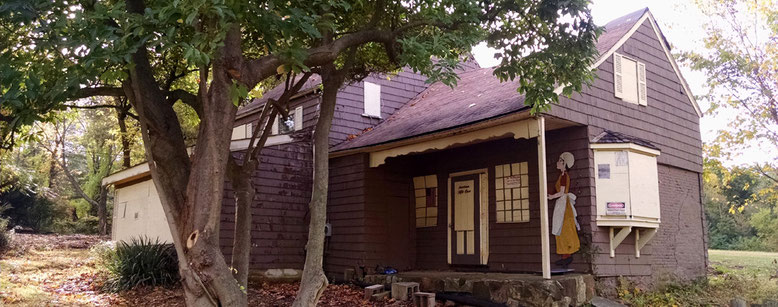 The first white man in the region was probably Verrazano in 1524, but the land was first claimed by the Dutch in 1609 as a result of Henry Hudson's explorations. The heartland of Scotch Plains was first owned by a Dutchman, Peter Sonmans, until the English conquest in 1664. Captain John Baker bought the region from the Indians before 1684 paying one cent for every 10 acres.
The first white man in the region was probably Verrazano in 1524, but the land was first claimed by the Dutch in 1609 as a result of Henry Hudson's explorations. The heartland of Scotch Plains was first owned by a Dutchman, Peter Sonmans, until the English conquest in 1664. Captain John Baker bought the region from the Indians before 1684 paying one cent for every 10 acres.
In 1684 and 1685, this hamlet was settled by Scotch immigrants who landed at Perth Amboy under the leadership of George Scot. Thus we were Scot's Plains. In those early days Scot's Plains was part of West Fields (later Westfield) which in turn was part of Elizabethtown. There were eight families in the original settlement living in wigwams or log cabins.
At the time, people traveled by horseback on Indian trails, later adorned with wagon wheel tracks from stagecoaches and buggies pulled by horses. These paths became our present main streets: Front Street, Park Avenue, Martine Avenue, Raritan Road and Westfield Road.
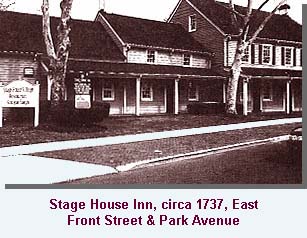 Scot's Plains, which included what is now Fanwood, grew slowly in population, and was a farming community for 200 years. In the 1720s, William Darby, a Baptist, gave part of his property to build a meetinghouse and a cemetery. It was christened as the first meeting house in Scotch Plains in 1742. Family bickering and moral dilemmas were addressed at weekly gatherings. On this property, a Baptist church was dedicated in 1747.
Scot's Plains, which included what is now Fanwood, grew slowly in population, and was a farming community for 200 years. In the 1720s, William Darby, a Baptist, gave part of his property to build a meetinghouse and a cemetery. It was christened as the first meeting house in Scotch Plains in 1742. Family bickering and moral dilemmas were addressed at weekly gatherings. On this property, a Baptist church was dedicated in 1747.
In the 1760s, Darby also gave land for the first school, an academy standing next to the church on Park Avenue (then called Darby Road). The church became the mother church of the Baptist Church of New York City during the colonial period. In 1762, this New York City Group joined with an upstate group to found Colgate University. The present Victorian Gothic church on the site was erected in 1870.
The cemetery contains brown sandstone markers from as early as 1742. Original settlers, slaves, and 24 Revolutionary War soldiers are buried there. It is on these grounds that our Scotch Plains patriots drilled.
The Stage House Inn was erected in 1737 by John Sutton as a hotel. By the time of the Revolutionary War it had become a tavern and home of Captain Recompense Stanbery, as well as a stopping place for the Swift and Sure Stage Line, which traveled from Philadelphia to New York. When the stage coach arrived at the inn with mail, a miniature cannon was shot off, and townspeople came by to pick up their mail.
Colonial leaders Lord Stirling and General Lafayette discussed battle plans at this tavern during the war. During the Civil War, it was a rallying point for Union recruits. Through the years, town festivities were held on its grounds. In the 1800s gypsies, traveling circuses, and migrant Kickapoo Indians camped in wigwams - the latter to sell their Kickapoo Juice remedy. In the 1900's clambakes and oyster feasts abounded on the site.
The Osborn-Cannonball House across the street sustained a stray cannonball as Washington's troops fled the large British force after the Battle of Short Hills, which occurred at the site of the present Ashbrook Golf Course. There were 6,000 colonial troops and 8,000 British soldiers passing through Scotch Plains during this battle.
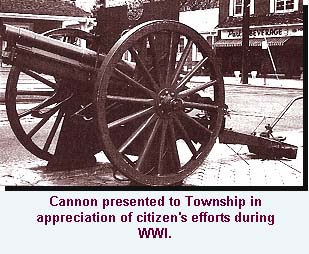 John Adams' son-in-law, Colonel William Smith, was in charge of a colonial encampment in Scotch Plains. In 1780, a cannon called "old one horn" was captured by Captain Eliakim Litttell and today is located in the Fairview Cemetery in Westfield. The colonials fared poorly. During the battle, 60 lives, three Officers and three cannons were lost, while 200 were wounded. Because this had been an early Indian camping ground, many arrowheads were found in developing the golf course.
John Adams' son-in-law, Colonel William Smith, was in charge of a colonial encampment in Scotch Plains. In 1780, a cannon called "old one horn" was captured by Captain Eliakim Litttell and today is located in the Fairview Cemetery in Westfield. The colonials fared poorly. During the battle, 60 lives, three Officers and three cannons were lost, while 200 were wounded. Because this had been an early Indian camping ground, many arrowheads were found in developing the golf course.
The Betsy Frazee house on Raritan Road was visited by Lord Charles Cornwallis and his men when they smelled baking bread. When Betsy said “I give you this bread in fear, not in love,” Cornwallis left without the bread.
In 1775, the center of Scotch Plains consisted of 11 houses including the Stage House Inn. Following the Revolutionary War our township started some growth. A reading society was formed in 1800, the local post office opened its doors in 1804, and a temperance society was formed in 1831.
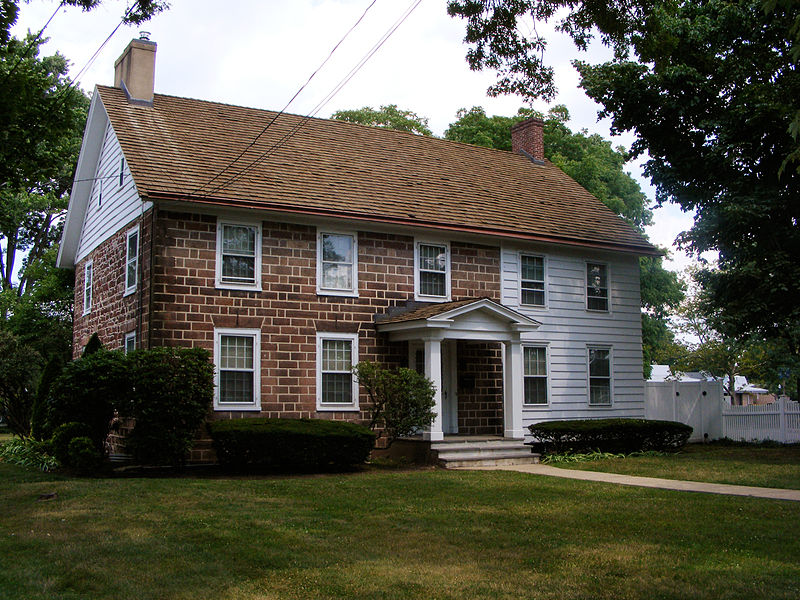 By 1838, the Elizabethtown and Somerville Railroad had reached Westfield, offering to purchase rights of way in Scotch Plains. When the townspeople would have no part of this, it passed east of our center to Plainfield, spurring Plainfield's growth. In 1851 three private schools were augmented by a public school system, and at the time of the Civil War in 1861, the village included one church, three private schools, one public school, one tavern, two stores, five mills, 70 houses, and many farms.
By 1838, the Elizabethtown and Somerville Railroad had reached Westfield, offering to purchase rights of way in Scotch Plains. When the townspeople would have no part of this, it passed east of our center to Plainfield, spurring Plainfield's growth. In 1851 three private schools were augmented by a public school system, and at the time of the Civil War in 1861, the village included one church, three private schools, one public school, one tavern, two stores, five mills, 70 houses, and many farms.
There were no paved roads, sidewalks, or street lighting in Scotch Plains. Following the Civil War, two other denominations arrived: Methodists in 1867 and Episcopalians in 1872. In 1867, the train depot on Midway Avenue was given the name Fanwood, and the 350 acres around it called Fanwood Park.
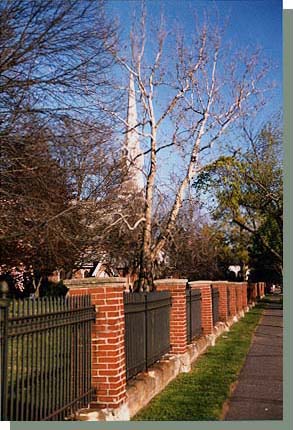 In 1869 the Excelsior Hook and Ladder Company No. 1, a volunteer firefighter company, was founded. In 1877 Scotch Plains divorced itself from Westfield, and became Fanwood Township. In 1895, one mile of land in the center separated itself, and became Fanwood Borough. It has remained separate ever since.
In 1869 the Excelsior Hook and Ladder Company No. 1, a volunteer firefighter company, was founded. In 1877 Scotch Plains divorced itself from Westfield, and became Fanwood Township. In 1895, one mile of land in the center separated itself, and became Fanwood Borough. It has remained separate ever since.
The railroad brought commuters and vacationers to Fanwood whose progressive ideas clashed with those of longtime residents of Scotch Plains. Clayton's History of Union County dated 1882 noted a population of 324, which didn't include the southside of Scotch Plains. Mentioned were three churches, one schoolhouse, two taverns, three grocery stores, a dry goods store, a paper factory, a drugstore, a shoemaker, and two butchers.
A formal public library was established when the "Union Church" (now Willow Grove Presbyterian) was built. The two Fanwoods existed side by side until March 22, 1917. On that day, through the efforts of George H. Johnston, the state Legislature agreed to give our town its original colonial name of Scotch Plains.
By World War I, Scotch Plains was becoming modern as paved streets replaced mud roads. Although the first Italian family settled in Scotch Plains in 1860, it was in the early 1900s that a big influx of Italian immigrants came, bringing with them skills in shoemaking, masonry, carpentry, and plumbing. Many arrived from the medieval hill town of Montazzoli, about 20 miles from the Adriatic Sea in central Italy. Four of their descendants have served as our mayors: Thomas Santo Salvo, Gene Novello, Mauro Checchio, and Thomas Santo Salvo, Jr.
Among the 89 veterans of World War I listed on our monument at Park Avenue and Front Street are many Italian names along with older pioneer names. The monument was dedicated in 1920. John Z. Hatfield opened festivities by accepting a captured German cannon presented by the U.S. government to our town as first prize to non-banking towns of the 2nd Federal District for the greatest percentage of oversubscription to the Victory Loan.
After World War I, Scotch Plains grew mostly in homes for commuters with construction of Route 22 in 1930, playing a part in the town's development. City people began to move here "to the country." At this time, Scotch Plains had the old School #1 built in 1890, School #3 built in 1915, School #4 in 1922, and a one room schoolhouse (School #2) on the southside. Fanwood had La Grande School (now Children's Specialized Hospital).
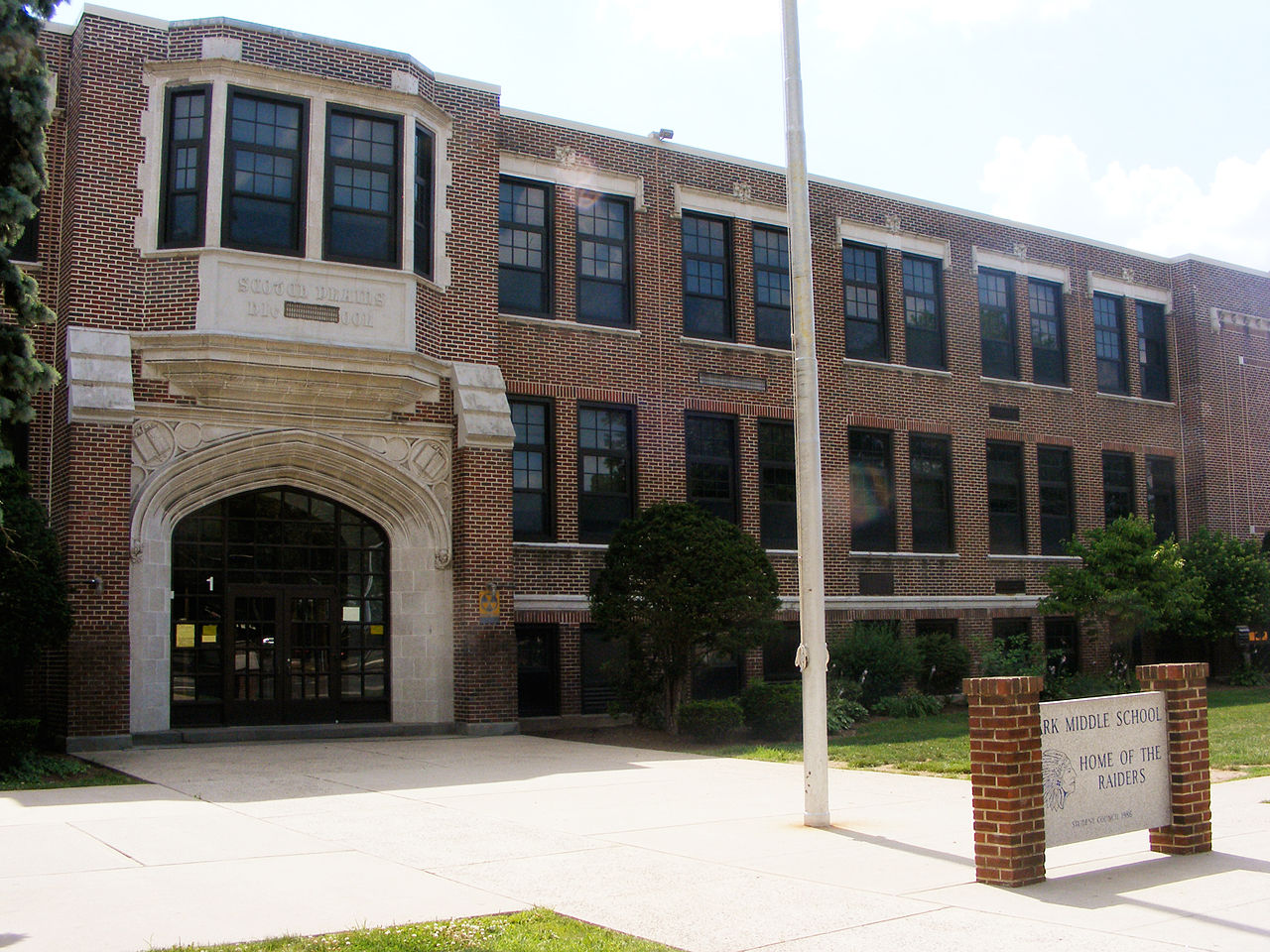 Fanwood and Scotch Plains have always shared a school system. Until 1925, high school students went to other towns. At that time, what is now Park Middle School was built as a high school and junior high.
Fanwood and Scotch Plains have always shared a school system. Until 1925, high school students went to other towns. At that time, what is now Park Middle School was built as a high school and junior high.
In 1921, Scotch Plains received national attention with the founding of the first African-American country club in the country, Shady Rest, originally the Ephraim Tucker farmhouse in the mid-1700s. It played host to famous black musicians such as Count Basie, Duke Ellington, Ella Fitzgerald, Cab Calloway, and Sarah Vaughn. Celebrities such as Joe Louis and Althea Gibson visited. From 1924 until 1960 John Shippen served as its golf pro. He too made history as the first American-born golf pro. In 1964, this building became the township-owned Scotch Hills Country Club.
During World War II, we were still mainly a rural town of 4,500. Nine hundred residents served our country in World War II. Fourteen of them gave their lives. During the Korean War and Vietnam Wars, we lost three brave men in each of them.
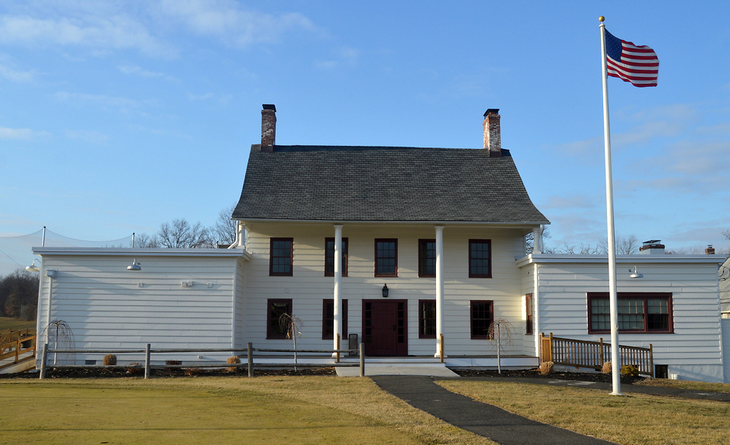 The biggest growth came after World War II in the 1950s and 1960s, especially on the south side where many big housing developments replaced tracts of farmland, prompting the immediate need for more public schools. Shackamaxon, Evergreen, Brunner, Coles, Terrill Middle School, Mc Ginn, and a new School #1 were added. In 1953, there were 10,000 people here and student enrollment in schools had doubled. A new high school was built, and the old one became Park Middle School.
The biggest growth came after World War II in the 1950s and 1960s, especially on the south side where many big housing developments replaced tracts of farmland, prompting the immediate need for more public schools. Shackamaxon, Evergreen, Brunner, Coles, Terrill Middle School, Mc Ginn, and a new School #1 were added. In 1953, there were 10,000 people here and student enrollment in schools had doubled. A new high school was built, and the old one became Park Middle School.
In 2018, Scotch Plains had more than 24,405 residents with many commuting to Newark, New York City and other job centers via convenient rail, road and bus. Scotch Plains has more churches, two synagogues, a YMCA, Jewish Community Center, many banks, restaurants, professional service providers and shops, serving the latest generation of a bustling, multi-ethnic community.
We are very fortunate to be part of a town with such a rich 300-year history. Not many towns can say that.
Learn more about Scotch Plains history by clicking here.
Important Facts and Information
Mayor and Township Council
Quick Facts - General Characteristics
Land Area – 9.0 Square Miles
Population – approx. 24,968
Median Age – 43.8
Persons Per Square Mile – 2,606
Per Capita Income - $60,896
Median Household Income - $131,732
Households - 8,761
Median Housing Value - $497,900
Median Rent - $1,584
Shady Rest Country Club – www.ShadyRestCountryClub.com/
Frazee House – www.FrazeeHouse.org
Osborne Cannonball House – www.HistoricalSocietyspfnj.org
Jewish Community Center of Central Jersey – www.jccnj.org
Fanwood-Scotch Plains YMCA – www.fspymca.org
Shackamaxon Country Club – www.Shackamaxoncc.com
Ashbrook Golf Course – www.AshbrookGolfCourse.com
Scotch Plains Department Directory
Administration
Al Mirabella, Township Manager
(908) 322-6700 ext. 313
Margaret Heisey, Deputy Township Manager
(908) 322-6700 ext. 314
Tom Strowe, Director of Redevelopment/Municipal Housing Liaison
(908) 322-6700 ext. 317
Clerk
Bonnie Lacina, Township Clerk
(908) 322-6700 ext. 211
Finance
Anders Hasseler, Chief Financial Officer
(908) 322-6700 ext. 200
Inspections Department
Robert LaCosta, Building, Engineering & Health
(908) 322-6700 ext. 306, 308, 309, 310
Library
The Scotch Plains Public Library
1927 Bartle Ave, Scotch Plains, NJ
(908) 322-5007
www.scotlib.org
Michelle Willis, Library Director
(908) 322-5007 ext. 202
Municipal Court
Court Administrator Office
(908) 322-6700 ext. 215
Jalessa Lewis, Court Administrator
Office of Emergency Management
430 Park Ave
www.scotchplainsnj.gov/OEM
Dennis VanNatta, OEM Director
(908) 322-6700 ext. 185
Public Safety
Police
Scotch Plains Police Department
430 Park Ave, Scotch Plains, NJ 07076
(908) 322-7100
www.scotchplainspolice.org
Jeff Briel, Police Chief
(908) 322-7100 ext. 102
Public Works Department
Frank DiNizo, Director
(908) 322-6700 ext. 243 or 244
Recreation Department
Julie Buonaguro, Director Parks & Recreation
(908) 322-6700 ext. 222
Rescue Squad
1916 Bartle Ave, Scotch Plains, NJ 07076
Daniel Sullivan, Rescue Squad Chief
(908) 322-2103
www.scotchplainsrescuesquad.com
Scotch Plains Fire Department
Station #161 (430 Senger Place)
Station #162 (1910 Raritan Road)
www.scotchplainsnj.gov
John Lestarchick, Fire Chief
(908) 322-6700 ext. 500
Tax Assessor
Mike Ross, Tax Assessor
(908) 322-6700 ext. 206
Tax Collector
Colleen Huehn, Tax Collector
(908) 322-6700 ext. 210
